Over the past two decades, a consensus has emerged on what countries need do to foster economic development, innovation and growth. This revolves around a three-pillar formula - of promoting human capital, building physical infrastructure and ensuring good governance, that development economists see as the minimum requirements for supporting a modern economy.
The first pillar - human capital - fuels economic growth and boosts higher labour productivity. Human capital is also crucial for innovation and the absorption of ideas and techniques from around the world. No country can expect fast continuing growth and be able to compete internationally without a commitment from its government to invest in skills. It is not surprising then that the world invests about 4.6 per cent of its GDP on education. Countries including South Korea, Ireland and Singapore are said to owe their swift advance to developed nation status to high levels of investment in education and human capital.
The second pillar - physical infrastructure - is a critical enabler of economic activity and a prerequisite for inward investment, trade and productive activities. Over the last five decades, governments across the world have invested huge amounts in building traditional infrastructures, such as transport networks, sewage systems and power grids. More recently, there has been massive investment in high tech infrastructure such as broadband networks and 3G mobile telecommunication systems.
The third pillar - good governance – is the most elusive, since it requires more than money to erect. The necessary elements range from having efficient and transparent public sector institutions, to strong and enforceable intellectual property rights, fair competition law and an independent judicial system.
Prescriptions for economic development
There is no doubt that this three pillars formula has helped many countries mobilise their resources more efficiently. But problems arise if this formula is viewed as an immutable prescription for economic development.
To start with investment in infrastructure: while development economists see this as a key enabler of economic growth, policymakers view it more as a driver of short-term economic revival, and invest in it accordingly. Very recently, both high tech and traditional infrastructures have seen new waves of investments as governments attempted to spend their way out of the global recession. Using such investments as a sticking plaster means they are geared towards short-term recovery, rather than long-term growth.
In some cases, it is not clear whether an expansion or an upgrade of infrastructure is needed. Take one example: given that 82 per cent of the US population is concentrated in cities and suburbs how much impact will upgrading rural America’s access to the Internet have on economic growth? Without clear evidence that more people would move from the cities to the countryside as a result of the upgrade, the impact of the new investments in broadband infrastructure on the growth of the rural economy will be limited.
Human capital and higher education
Investment in human capital has followed a similar logic, with more education coming to be equated with more higher education. Across much of the world, demand for higher education has soared, universities are overcrowded, staff overworked, and the quality of graduates is falling as a result. Take for example the situation in the UK, where government policy of encouraging more people into higher education has produced a glut of graduates and strained the capacity of UK universities.
In developing countries, the situation is worse. In Jordan, Egypt and across much of the Arab world, university graduates en masse are either unemployed, take lower-skilled jobs, or emigrate. In fact, the oversupply of university graduates has crowded non-university graduates out of the labour market and pushed down salaries.
What makes good governance?
Good governance is important, and developing countries in particular still need to make long strides in this regard. But countries that are often regarded as lacking in this respect, for example, China, Vietnam, Russia and India, have double digit growth. It seems that in this context “good” may mean something else, perhaps more along the definition of Harvard University economist Dani Roderik who emphasises the stability and predictability of governance structures in an economy, rather than their efficient performance.
Companies from the developing world seem to take a different approach to good governance. Chinese, Indian and Arab telecom companies are very active and successful in regions such as Africa and Central Asia, where good governance is supposedly a rare commodity. Investors, it seems, are driven more by opportunity than ‘good governance’ while ‘good governments’ seem to know that, and take it into consideration when inducing foreign companies to invest in their economies.
Unless there is a United Nations embargo on a country, foreign investors tend to move in on the basis of special arrangements and agreements with the government of the host country, without demanding substantial reforms to the governance culture and structure.
Which pillar comes next?
While infrastructure, human capital and good governance are crucial ingredients, the question in the minds of policymakers from Canada to Singapore is What next? Advanced economies with high levels of human capital, advanced infrastructure and good governance are stagnating. To highlight one example: despite all the hoopla around Finland’s investment in new infrastructure, human capital, and the country’s good governance, it still occupies a mid-table position in the EU’s GDP per capita rankings.
There’s no straightforward answer. But one area worth exploring is efficacy. Countries with similar levels of socio-economic development and physical and social infrastructure, often display different levels of economic performance. So for example, there is a productivity gap between the EU and the US, while Northern Europe has higher productivity levels than the Mediterranean region. Malaysia and Korea started off with similar levels of human development but with different natural resource endowments (Malaysia was richer). Both invested in infrastructure, human capital, and good institutions, but South Korea managed to grow much faster.
Why is it that some countries make better use of their human capital, physical and social infrastructure than others? Why does one village gain more benefit from getting access to broadband connectivity than other villages, and one country manage to deploy its talents, while other countries are exporting their skills? The reasons for such “Efficacy Gaps” remain unclear.
Whatever the answer, one thing is clear: there needs to be better alignment between investment in physical and social infrastructure, and the associated opportunity. The ‘build it and they will come’ approach to investment is a recipe for generating inefficiencies in any economy.
In summary, infrastructure, education and good governance are enablers, not drivers of economic development. Given this, governments should link investments in infrastructure and human capital to specific growth opportunities, where there is solid evidence that an expanded and upgraded capacity will make a real difference.
Sami Mahroum, is Director of INSEAD’s Innovation & Policy Initiative, at the Abu Dhabi Campus. This article has also appeared in Arab News.





 A unique international forum for public research organisations and companies to connect their external engagement with strategic interests around their R&D system.
A unique international forum for public research organisations and companies to connect their external engagement with strategic interests around their R&D system.